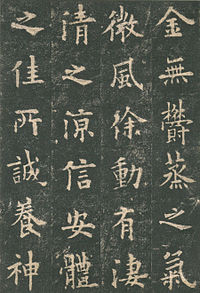
Back Kāi-cṳ̆ CDO Vzorové písmo Czech Regelschrift German Escritura regular Spanish Kaishu Finnish Style régulier French Kaj-su Hungarian Aksara reguler ID Stile regolare Italian 楷書体 Japanese
| Regular script | |
|---|---|
 | |
| Script type | |
Time period | c. 2nd century – present |
| Languages | Classical Chinese, vernacular Chinese varieties |
| Related scripts | |
Parent systems | Oracle bone script
|
Child systems | |
| Unicode | |
| |
| Regular script | |||||||||||||||||
|---|---|---|---|---|---|---|---|---|---|---|---|---|---|---|---|---|---|
 "Regular script" written in traditional (left) and simplified (right) forms | |||||||||||||||||
| Chinese name | |||||||||||||||||
| Traditional Chinese | 楷書 | ||||||||||||||||
| Simplified Chinese | 楷书 | ||||||||||||||||
| Literal meaning | model script | ||||||||||||||||
| |||||||||||||||||
| Alternative Chinese name | |||||||||||||||||
| Traditional Chinese | 真書 | ||||||||||||||||
| Simplified Chinese | 真书 | ||||||||||||||||
| Literal meaning | real script | ||||||||||||||||
| |||||||||||||||||
| Second alternative Chinese name | |||||||||||||||||
| Chinese | 正楷 | ||||||||||||||||
| Literal meaning | correct model | ||||||||||||||||
| |||||||||||||||||
| Third alternative Chinese name | |||||||||||||||||
| Traditional Chinese | 楷體 | ||||||||||||||||
| Simplified Chinese | 楷体 | ||||||||||||||||
| Literal meaning | model form | ||||||||||||||||
| |||||||||||||||||
| Fourth alternative Chinese name | |||||||||||||||||
| Traditional Chinese | 正書 | ||||||||||||||||
| Simplified Chinese | 正书 | ||||||||||||||||
| Literal meaning | correct script | ||||||||||||||||
| |||||||||||||||||
| Vietnamese name | |||||||||||||||||
| Vietnamese alphabet |
| ||||||||||||||||
| Hán-Nôm |
| ||||||||||||||||
| Japanese name | |||||||||||||||||
| Kanji | 楷書 | ||||||||||||||||
| Hiragana | かいしょ | ||||||||||||||||
| |||||||||||||||||
The regular script[a] is the newest of the Chinese script styles, popular starting from the Three Kingdoms period c. 200 CE, and stylistically mature by the 7th century. It is the most common style used in modern text. In its traditional form it is the third-most common in publishing after the Ming and Gothic types used exclusively in print.[1]
Cite error: There are <ref group=lower-alpha> tags or {{efn}} templates on this page, but the references will not show without a {{reflist|group=lower-alpha}} template or {{notelist}} template (see the help page).
- ^ "Chinese Writing". Asia Society. Retrieved 2023-10-01.
© MMXXIII Rich X Search. We shall prevail. All rights reserved. Rich X Search
